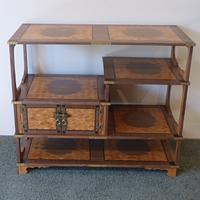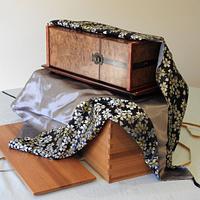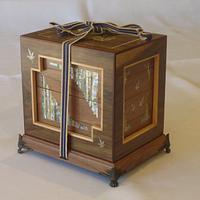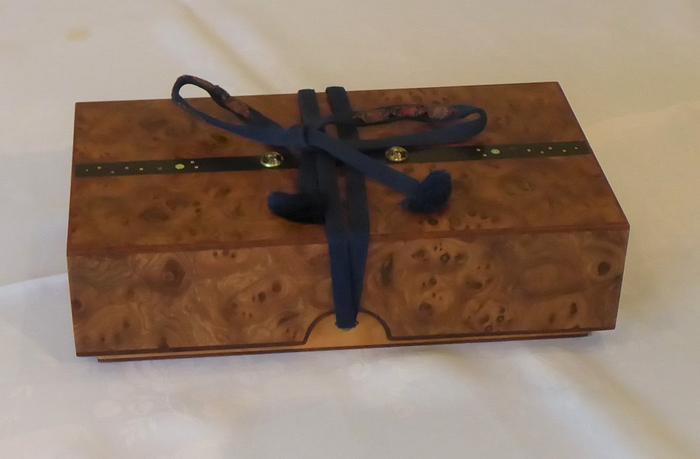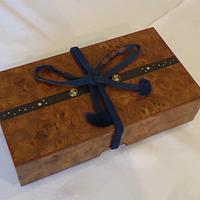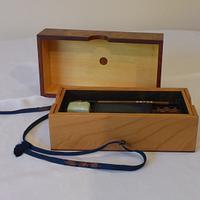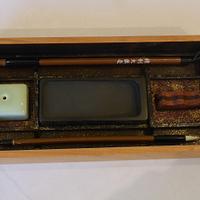Share your craft projects
Make new craft buddies
Ask craft questions
Blog your craft journey
Madburg
426 posts
and
20 followers
in almost 3 years
in almost 3 years
More from Madburg
Japanese writing Box - Suzuribako - Jupiter
Jupiter
Before we get into what the project, Why is it called Jupiter? Well Jupiter has many small moons or satellites which orbit the planet and are thought to be the cause of its characteristic rings. Two relatively 'new' small moons, Adrastea and Metis, discovered by the last Voyager probe, are some of the ones closest to Jupiter orbiting in its main innermost ring. Dust from them is thought to be the cause this ring.
So Jupiter and its many rings and moons - the black band with dots and cabochons, provided the inspiration for the name of the box. The style follows on another of my Japanese boxes 'Starry, Starry night'.
Before we get into what the project, Why is it called Jupiter? Well Jupiter has many small moons or satellites which orbit the planet and are thought to be the cause of its characteristic rings. Two relatively 'new' small moons, Adrastea and Metis, discovered by the last Voyager probe, are some of the ones closest to Jupiter orbiting in its main innermost ring. Dust from them is thought to be the cause this ring.
So Jupiter and its many rings and moons - the black band with dots and cabochons, provided the inspiration for the name of the box. The style follows on another of my Japanese boxes 'Starry, Starry night'.

The lift off lid, held in place with a traditional obijimi sash, is veneered marine ply, with book matched burl elm on the outside with jarrah edging, and paulownia veneer on the inside. It has a dyed black band - Jupiter's ring, running across the top and down the ends. This is inlayed with a range of small shell and opal dots, representing Jupiter's moonlets and satellites, with the two larger cabochon stud earrings, being Adrastea and Metis.
But, what is the box? Continuing with my Japanese inspired boxes, this is a traditional writing box - Suminbo, It is used to hold a range of tools and equipment associated with Japanese calligraphy - Shado. It is a little more complex than my previous Suzuribako, check it out here.
The main box/base and the internal writing tray, are made from cherry.

The lift-out Suzuribako contains calligraphy traditional tools. An Inkstone 硯 - Suzuri, a water dropper 水差し - Mizusashi, two brushes 筆 - Fude, and a brush rest 筆置 - Fude oki.
It seems that in times gone bye people had to make their own tools in order to practice shodo, but today you can find all the necessary objects in stores across Japan or other countries. I got most of mine from AliExpress. The Suzuri - inkstone, and the Sumi - inkstick, where given to me be the eventual recipient of the box - little did he know he would get them back!


The inside of the Suzuribako tray and its interior framework have been ebonised and then sprinkled with gold dust to reflect traditional Japanese black lacquer.

I use polyurethane instead of traditional lacquer - urushi. A couple of coats are applied and rubbed down, then another coat is applied, and while still wet the gold dust, or you can use fine glitter, is sprinkled on. This is left to dry after which I brush off any loose dust before applying another two or three coats of polyurethane to cover the gold dust. I then rub it down with 400 grit and apply more coats until the gold dust is completely sealed and I can rub it down to get a flat satin finish.
Beneath the Suzuribako in the base of the box are more traditional items. All of which have their own specific Japanese names.

Two paper weights 文鎮 - Bunchin, made from Mexican Rosewood with shell dot inlays and grooves to act as brush rests. A paper knife ペーパーナイフ - Pepanaifu. A brush hanger 笔挂 - Burashihanga, for hanging cleaned brushes after they have been cleaned to allow them to dry. A solid inkstick 墨 - Sumi in its own paulownia box. Also included is an uncarved soap stone seal 判子 - Hanko.

Making boxes that have a specific purpose and hold a specific set items is more challenging than making an empty box. Things have to fit, and fit in particular positions, so the internal layout and associated sizes and tolerances have to be precise and carefully built into the design. Many of my boxes are just empty containers - you put in what you want and arrange things as best you can. So finished sizes don't really matter, and a few millimetres discrepancy from the original sizes are OK.
The whole box is gift wrapped in a traditional Furoshiki cloth.

It was made as a surprise for a very good Japanese friend who has given me so much encouragement, and help with translations while researching many of my Japanese boxes. Thank you Tad!
As ever thanks for looking, and if you have nay questions please ask.
Hope you enjoyed it
5 Comments
love it , over the top as usual !
working with my hands is a joy,it gives me a sense of fulfillment,somthing so many seek and so few find.-SAM MALOOF.
Beautiful
Ryan/// ~sigh~ I blew up another bowl. Moke told me "I made the inside bigger than the outside".
Both boxes are really wonderfully done.
Ron
Another great creation, a wonderful design and write up. Inspiration for sure.
Main Street to the Mountains
Quite impressive. Kudos!
Knowing how to use a tool is more important than the tool in and of itself. - Ron Aylor









